Practical guide on the topic "How to sprout peas" from experienced summer residents
Many people think that peas are germinated only before planting in the garden. Nothing like this. It turns out that sprouted peas are eaten, and its useful properties cannot be counted right away.
Read on to learn how to sprout peas at home, how it is useful and what it is eaten with. In the article, you will also find instructions for planting and caring for peas.
The content of the article
The benefits of seedlings for men and women
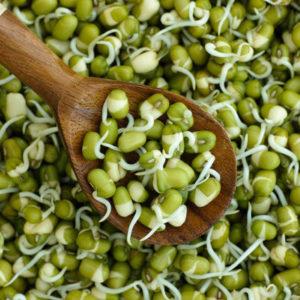 Peas contain a large amount of nutrients: potassium, calcium, magnesium, sodium, phosphorus, iron, manganese, copper, selenium, zinc. And in the seedlings of this culture, their composition doubles. In addition, sprouted peas are better absorbed by the body than grains without sprouts and do not cause flatulence.
Peas contain a large amount of nutrients: potassium, calcium, magnesium, sodium, phosphorus, iron, manganese, copper, selenium, zinc. And in the seedlings of this culture, their composition doubles. In addition, sprouted peas are better absorbed by the body than grains without sprouts and do not cause flatulence.
How do pea sprouts affect the body? They lower blood cholesterol levels, have a positive effect on the digestive system and improve brain activity. Sprouted peas useful with diabetes mellitus, as well as people with a predisposition to this disease. It helps regulate blood glucose levels and reduces the risk of illness.
For men, sprouted peas are useful in that they have a positive effect on the functioning of the male reproductive system. It reduces the risk of prostatitis and other genitourinary diseases.
The sprouts are also very beneficial for women. Note for those losing weight: sprouted peas are a low-calorie product, while giving a feeling of fullness and promoting fat burning. It has a rejuvenating effect and removes toxins from the body.
Caution! With the use of sprouted peas, the main thing is not to overdo it. Introduce it gradually to avoid unpleasant side effects. Start with one teaspoon per day and work up to 70 grams per day over two to three months.
Benefits for children
With adults it's clear. What about children? Can they sprouted peas? Can. But here it is also important to monitor the amount of sprouts consumed.
In addition to the above micro and macro elements, sprouted peas contain vitamins B1, B2, B5, B6, B9, C and A. So sprouted peas in reasonable quantities will become useful food for a child.
Eating sprouted peas as a raw foodist
Any living organism needs protein to be strong and healthy. Most protein is found in animal foods, which vegetarians and raw foodists refuse. Legumes can easily replace meat as a source of protein and other elements necessary for the body., and especially sprouted peas.
Calorie content and nutritional value
The energy value of 100 grams of sprouted peas is 124 kcal / 519 kJ. Proteins - 8.8 g; fats - 0.7 g; carbohydrates - 27.1 g.
Soak peas before planting
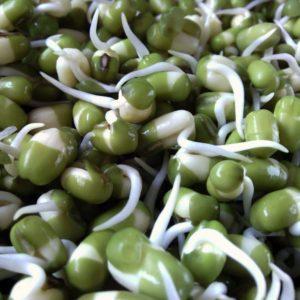 There are two diametrically opposed opinions on whether to soak peas before landing... Seeds soaked before planting germinate faster than dry seeds, and also give a greater yield. But caring for them is a little more difficult. Since these legumes love water, they need abundant and consistent watering.
There are two diametrically opposed opinions on whether to soak peas before landing... Seeds soaked before planting germinate faster than dry seeds, and also give a greater yield. But caring for them is a little more difficult. Since these legumes love water, they need abundant and consistent watering.
Dry peas can survive in dry ground if you don't have the opportunity to water them constantly. The pickled grains will die without the proper amount of moisture.
First you need to select the right seeds. They must be whole and healthy. Dissolve 1 tablespoon of table salt in 1 liter of warm water and dip the peas in the solution. We will plant only those grains that have sunk to the bottom.
Now we can proceed to soaking. There are two common options for sprouting peas before planting: in water and wet gauze.
First option: fill the peas with water at room temperature so that it covers the seeds completely. Within 12-16 hours, we change the water every 3 hours. This time is enough for the peas to swell and germinate a little. Then we drain all the water, put the peas on a dry cloth, let them dry a little.
Second option: wrap the peas in cheesecloth, fill with water for 3 hours. After that, we keep the grains in damp gauze for 3-5 days. Our peas are ready to be planted in the ground.
For the first 3 hours, the peas can be soaked in a special solution. The most common ones are: "Gumat", "Epin", "Rizotorfin" and "Nitragin".
Planting and caring for peas
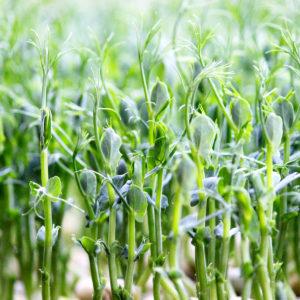 Polka dots love the sun. Therefore, it should be planted in a sunny place, preferably protected from the wind.
Polka dots love the sun. Therefore, it should be planted in a sunny place, preferably protected from the wind.
The planting bed must be prepared in the fall. To start - dig to the depth of the fertile layer (22-25 cm). You can fill the soil with compost and ash, or superphosphate and potassium salt.
In the spring, we process the garden as early as possible: we loosen the soil to a depth of about 10 cm. Add ash and 10-15 g of urea per 1 sq. m. to the ground. The latter can be replaced with 20-25 g of ammonium nitrate.
Peas can be sown quite early - starting from the 20th of April. Planting early ripening varieties can be produced until mid-summer (until about July 10).
The day before planting, the garden bed must be leveled and shed well. Spill the soil again just before planting. We will plant peas to a depth of 4-6 cm. The distance between the rows should be at least 20 centimeters. Every 8-10 cm, we plant two peas at once, or one every 4-6 cm. Cover the holes with peas with earth and compact them a little.
Until seedlings emerge, the bed can be covered with foil to protect the seeds from birds and retain moisture and heat. With the first shoots, the film must be removed.
The first shoots should appear 6-15 days after planting.
Pea care is not difficult. The main thing is regular watering, weeding and timely harvesting. A separate item that peas need is support. When peas grow, they need to cling to something so as not to fall to the ground.
It is very easy to build a support. We insert pegs 1-1.5 m high into the ground. The distance between the pegs can be 50-100 cm. Between them we pull a coarse net, or several rows of rope to form a “fence”. Our peas will wrap around it.
Depending on the variety, the peas begin to bloom 30-60 days after planting. A month after that, the first crop can be harvested.
Germinating pea seeds for food: instructions
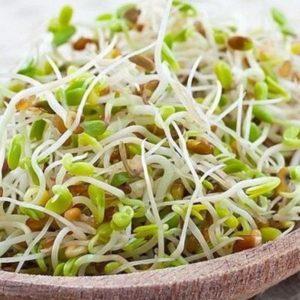 To sprout peas for food, we need pea seeds for sprouting, a colander, a container, and warm water. First, put the peas in a colander and rinse thoroughly with warm water for 1-2 minutes.
To sprout peas for food, we need pea seeds for sprouting, a colander, a container, and warm water. First, put the peas in a colander and rinse thoroughly with warm water for 1-2 minutes.
Next, evenly distribute the peas along the bottom of the container and fill with water at room temperature so that its level is about 1 cm higher than the peas. Cover with a lid so that air enters the container. We put it in a warm place for 12-15 hours.
After this time, rinse the peas and container thoroughly again. We leave some water at the very bottom and close it loosely with a lid. Every 2-3 hours we spray the peas with water from a spray bottle so that they do not dry out.
After 6 hours, rinse the peas again, sprinkle and put in a warm place. Repeat spraying every 2-3 hours for 12 hours.
After 12 hours, rinse the peas again and drain the water completely. We put the sprouted peas in the refrigerator - they are ready to eat.
Important! Sprouted peas can be stored in the refrigerator for a maximum of 5 days, so do not sprout peas in large portions at once.
Selection and preparation of seeds
The shops sell special pea seeds for germination. You will not be able to sprout peas-groats, but seed for planting can not be eaten.
The peas should be whole, well dried, small, yellow or green in color.
Before germination, be sure to rinse the seeds with warm water several times.
Conditions for growing peas at home
You can grow ripe, sweet, real green peas in winter. Right on my windowsill.
For this, we need deep boxes or spacious pots and support for future sprouts. Choose a bright place, provide the plantings with oxygen and stable watering.
Preparing grains for planting at home is no different from preparing for planting in open ground.
Tricks of growing peas on a windowsill
 For germination of sprouts, it is recommended to plant peas at a distance of 3-4 cm from each other in a common box. As soon as the seedlings form two leaves, they must be transplanted into individual pots. (300-500 ml), or plant it wider in a common box, increasing the distance between the shoots.
For germination of sprouts, it is recommended to plant peas at a distance of 3-4 cm from each other in a common box. As soon as the seedlings form two leaves, they must be transplanted into individual pots. (300-500 ml), or plant it wider in a common box, increasing the distance between the shoots.
Peas need light at least 12 hours a day. In winter, it is impossible to provide it with natural sunlight for such a time, therefore fluorescent lamps are used. They need to be placed at a distance of 50 cm from the pot.
Before flowering, it is sufficient to water the peas 1-2 times a week. During flowering and fruiting, increase watering up to 3-4 times a week. Remember to loosen the soil after each watering.
Remember that shooters who have reached the size of 10-15 cm need support. Pegs with a net or rope stretched between them are also suitable here, only they need to be placed at a smaller distance from each other.
During flowering, it is necessary to make several dressings with a solution of potassium salt and superphosphate (10-15 g per 10 liters of water).
You need to harvest every 1-2 days, so as not to interfere with the next ripening pods.
Pea sprouts in cooking
Sprouted peas are eaten neat, and also added to a variety of dishes: salads, soups, mashed potatoes, smoothies, stew with vegetables and meat.
Sprouted Pea Salad Recipe
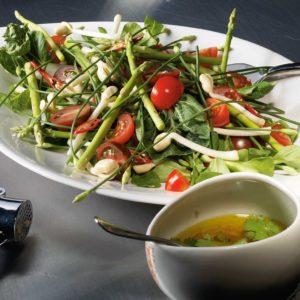 Salad:
Salad:
- radish - 5-7 pcs.;
- cucumber - 2 pcs.;
- feta cheese - 60 g;
- pea sprouts - 50 g.
Refueling:
- 1/2 orange juice;
- olive oil - 30 ml;
- mustard - 1/2 tsp;
- balsamic vinegar - 1 tsp;
- salt and pepper to taste.
Cut the radish and cucumber into small cubes. Coarsely chop feta cheese, add it to vegetables along with sprouted peas. We mix all the ingredients for the dressing. Season the salad and mix well. Let the dressing soak for about 30 minutes.
Enjoy your meal!
Conclusion
Peas are a useful and unpretentious crop to grow. Sprouted beans double their health benefits. The main thing is to observe restrictions on the use of sprouted grains. Anyone can grow peas: both in the garden and on the windowsill. It does not require much effort from the gardener, and the harvest will delight you soon.